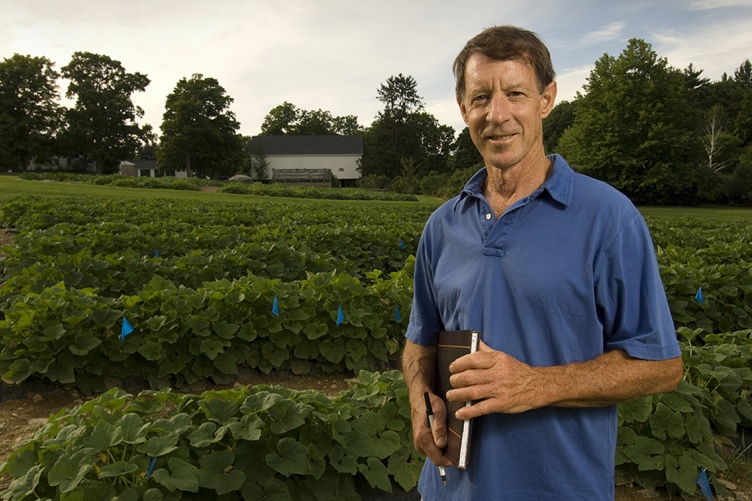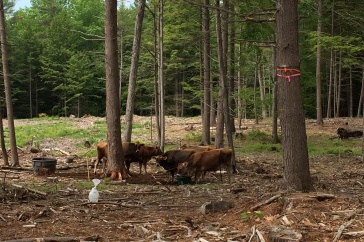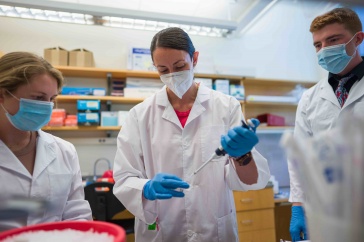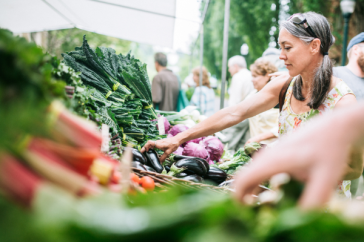
J.Brent Loy, emeritus professor of plant genetics and a researcher with the NH Agricultural Experiment Station, was recognized for three licenses for his pumpkin hybrid and squash inbred seeds.
Researchers from the College of Life Sciences and Agriculture and the NH Agricultural Experiment Station at the University of New Hampshire recently were honored for their intellectual property contributions to the university in the last year, including new inventions that manipulate the caffeine content in a tea plant and the development of a new way of detecting a pathogenic virus in shellfish.
Several faculty and former faculty members, graduate students, and business partners were recognized by the university at the 2015 Innovators Dinner hosted by UNHInnovation. UNHInnovation advocates for, manages, and promotes UNH’s intellectual property. UNHInnovation strives to create partnerships between UNH and the business community and is responsible for licensing UNH innovations and supporting start-up companies based on UNH's innovations.

“The NH Agricultural Experiment Station’s core mission is to create unbiased knowledge and new technologies of potential value to the state, region, and nation. It’s gratifying to see our many outstanding college and experiment station scientists working with UNHInnovation toward transitioning these innovations to sectors where they’re directly available for broader applications. As an institution, UNH continues to value and validate our land-grant partnerships with the state,” said Jon Wraith, dean of the UNH College of Life Sciences and Agriculture, and director of the NH Agricultural Experiment Station.
UNH’s cumulative intellectual property revenue exceeded $4.4 million in fiscal year 2015. UNH grants an average of one intellectual property license a day, which allows business and industry to commercialize and benefit from innovations developed at the university. Today, UNH is among the top 20 universities in the nation regarding the number of intellectual property licenses granted each year.
”The annual Innovators Dinner is a wonderful opportunity for UNH to truly celebrate both its innovators as well as their unique and creative work. The innovations are an extension of UNH’s excellence in research and become the foundation for goods and services that can benefit larger audiences,” said Maria Emanuel, associate director of UNHInnovation.
Subhash Minocha, professor of plant biology and genetics and a researcher with the NH Agricultural Experiment Station, was recognized as a first-time inventor for his project “Developing a Naturally Caffeine-Free Tea Plant Using the Modern Techniques of Genetic Engineering.” The research will produce plants that are naturally decaffeinated vs. those from which caffeine is removed by chemical methods to produce decaffeinated tea.
Minocha and his research team are using a combination of antisense RNA and genome editing technologies to reduce the function of the enzyme controlling caffeine synthesis. Also, using overexpression of this gene, they expect to generate a tea plant that should produce higher concentrations of caffeine in the leaves.
Cheryl Whistler, associate professor of molecular, cellular, and biomedical sciences and a researcher with the NH Agricultural Experiment Station, was recognized as a first-time inventor for her innovation “Targeted Molecular Detection of Invasive Vibrio Parahaemolyticus.” Whistler discovered a new method to detect a bacterium that has contaminated New England oyster beds and sickened consumers who ate the contaminated shellfish. The new patent-pending detection method – which is available for immediate use to identify contaminated shellfish – is a significant advance in efforts to identify shellfish harboring disease-carrying strains of Vibrio parahaemolyticus.
Chuck Walker, professor of molecular, cellular and biomedical science, was recognized as a first-time inventor for his innovation “Isolation and Characterization of the Steamer Retrotransposon in Leukemic Clam Hemocytes.” The Atlantic soft-shell clam inhabits a range extending from Canada to Maryland. Haemic Neoplasia (HN) is a recognizable leukemic-like disease in mollusks and can cause epidemics in populations such as the Atlantic soft-shell clam. Working with a team of researchers led by Stephen Goff of Columbia University, Walker helped identify “Steamer,” a novel mollusk retroelement that is elevated in HN-diseased clam populations. The finding can be used in laboratory tests for aquatic health, including the diagnosis of leukemic animals, as well as improve our understanding of the cause and potential treatments of human leukemia. A pending patent application for the research has been licensed to a New England company for commercialization opportunities.
Peter Erickson, professor of biological sciences, extension dairy specialist and a researcher with the NH Agricultural Experiment Station, and graduate students Kayla Aragona, were recognized as first-time inventors for their innovation “Niacin Supplementation to Prepartum Dairy Cows: Effects Postpartum.” Niacin supplementation has been studied in cattle but with no regard to how its potential mechanism of increasing blood flow may affect colostrum quality. Colostrum is essential in the neonatal calf diet as it provides necessary antibodies for survival. Researchers found that supplementing niacin during colostrogenesis (four weeks prepartum) resulted in an increase in Immunoglobulin G, which is a type of antibody, compared to cows not receiving niacin.
J. Brent Loy, emeritus professor of plant genetics and a researcher with the NH Agricultural Experiment Station, was recognized for three licenses for his pumpkin hybrid and squash inbred seeds. The seeds were licensed to Seedway, LLC, and Hybrid Seed Co. In 2011, Loy was awarded the university’s inaugural Innovator of the Year Award for his research program and impact on UNH’s commercialization efforts. A plant breeder whose experiment station-funded work has resulted in more than 50 new varieties of tomato, squash, pumpkins, gourds, and melons sold in seed catalogs throughout the world, Loy is responsible for 35 percent of the university’s cumulative royalties earned since 1999. The Innovator of the Year Award has been named after Loy since its creation.
Jennifer Durant, former assistant research professor of molecular, cellular, and biomedical sciences, was recognized for her innovation “Vinyl Acid Monomer Recovery.” Durant invented a method to directly purify and extract sodium itaconate, a bio-based molecule, from the fermentation media used to produce itaconic acid from carbohydrates. This method provides significant economies in the vertical integration path from plant-based carbohydrates to consumer products such as bio-based detergents and bio-based paints. This new, patented technology is licensed to Itaconix Corporation of Stratham, a start-up company from UNH to develop highly functional polymers from itaconic acid.
Many of the innovations described above are available for commercialization; interested parties should contact Maria Emanuel at maria.emanuel@unh.edu.
Founded in 1887, the NH Agricultural Experiment Station at the UNH College of Life Sciences and Agriculture is UNH’s original research center and an elemental component of New Hampshire's land-grant university heritage and mission. We steward federal and state funding, including support from the USDA National Institute of Food and Agriculture, to provide unbiased and objective research concerning diverse aspects of sustainable agriculture and foods, aquaculture, forest management, and related wildlife, natural resources and rural community topics. We maintain the Woodman and Kingman agronomy and horticultural farms, the Macfarlane Greenhouses, the Fairchild Dairy Teaching and Research Center, and the Organic Dairy Research Farm. Additional properties also provide forage, forests and woodlands in direct support to research, teaching, and outreach.
-
Written By:
Lori Tyler Gula, PhD | NH Agricultural Experiment Station | lori.gula@unh.edu | 603-862-1452

















































